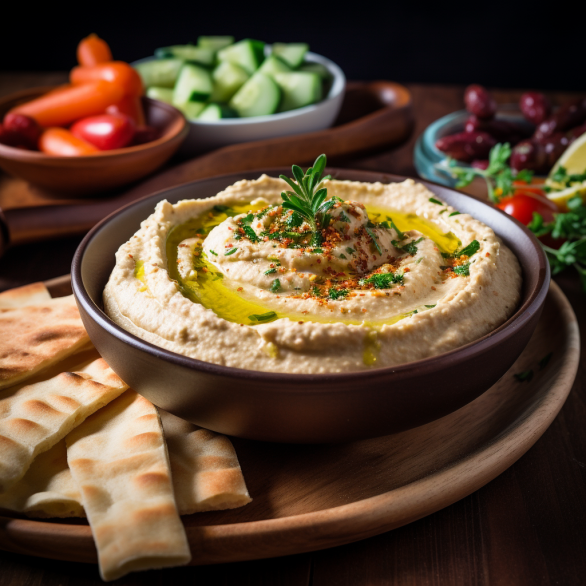A Journey Through Time: The Evolution of Greek Meze
Greek cuisine is renowned for its rich flavors and vibrant dishes, and traditional Greek meze (appetizers) are no exception. These small, flavorful bites have a long and fascinating history that dates back to ancient Greece. The origins of meze in ancient Greece highlight the communal and social nature of Greek dining, where sharing food was a way to bring people together, as seen in various myths and stories. Over time, meze has evolved and become an essential part of Greek cuisine, representing the country’s culinary heritage and regional variations.
When it comes to popular Greek meze dishes, there are several iconic options that are loved by locals and visitors alike. Tzatziki, a refreshing yogurt and cucumber dip, is often served with warm pita bread. Spanakopita, a savory pastry filled with spinach and feta cheese, is another beloved meze option. Dolmades, stuffed grape leaves with a flavorful rice and herb filling, are a classic choice.
Greek Salad, a vibrant mix of fresh tomatoes, cucumbers, onions, olives, and feta cheese, is a staple on meze platters. Saganaki, a fried cheese dish typically made with salty Greek cheese, is a popular meze favorite. Taramosalata, a creamy and tangy fish roe dip, and Melitzanosalata, a smoky eggplant dip, are also frequently enjoyed meze options. To complement the flavors of these meze dishes, traditional Greek meze pairings are often chosen to enhance the dining experience.
Ouzo, an anise-flavored liqueur, is one of the most well-known and popular pairings. Retsina, a Greek white wine with a distinctive resinous flavor, is also a traditional choice. Tsipouro, a grape pomace brandy, and various Greek wines, such as Assyrtiko, Agiorgitiko, and Xinomavro, are frequently enjoyed alongside meze. Finally, if you want to experience the deliciousness of traditional Greek meze at home, preparing these dishes is a rewarding and enjoyable endeavor. From making your own tzatziki to mastering the art of dolmades, there are countless recipes available that allow you to recreate the flavors of Greece in your own kitchen.
With fresh ingredients and simple techniques, you can savor the authenticity and taste of traditional Greek meze right at home. Whether you’re at a taverna in Greece or enjoying meze in your own kitchen, traditional Greek meze is a delightful culinary experience that combines history, flavor, and communal dining. Explore the world of Greek meze, try different flavors and combinations, and immerse yourself in the deliciousness of this beloved aspect of Greek cuisine.

Key takeaway:
- Traditional Greek Meze: Traditional Greek meze refers to a variety of small dishes and appetizers that are served to accompany drinks or as a meal. They showcase the rich flavors and ingredients of Greek cuisine.
- History and Evolution of Greek Meze: Greek meze has its origins in ancient Greece and has evolved over time to include a wide range of dishes. It reflects the influence of different cultures and showcases the diversity of Greek culinary traditions.
- Pairs Perfectly with Greek Drinks: Traditional Greek meze is often enjoyed with traditional Greek drinks such as ouzo, retsina, tsipouro, and Greek wines. These pairings enhance the flavors of the meze and create a harmonious dining experience.
History of Greek Meze
Discover the rich history behind everyone’s favorite Greek culinary tradition: Meze! Uncover the origins of Meze in ancient Greece and trace its fascinating evolution through Greek cuisine. Delve into the tantalizing world of small plates and appetizers that have delighted Greek food enthusiasts for centuries. From the early days of communal dining to the modern array of flavors, this section will take you on a flavorful journey through the history of Greek Meze.
Origins of Meze in Ancient Greece
In ancient Greece, the origins of meze can be traced back to the symposiums, where Greek men gathered to discuss various topics and enjoy food and wine. Meze, which translates to “small portion” in Greek, consisted of a variety of savory snacks and small plates that were meant to be shared among friends and family. This tradition of meze originated as a way to enjoy small bites alongside alcoholic beverages, bringing people together and fostering a sense of togetherness and conversation during meals.
During ancient times, meze dishes included popular ingredients like olives, cheese, bread, and seafood. These dishes showcased the culinary prowess of the host and were prepared in different ways, creating a diverse spread of flavors. Meze was not only a way to satisfy hunger but also enhanced the overall dining experience during symposiums, providing sustenance and celebrating the rich history and flavors of ancient Greece.
Today, meze continues to be an integral part of Greek cuisine and culture. Whether enjoyed at a Greek dinner party or as part of a small plates meal, meze brings people together and celebrates the origins of meze in ancient Greece. So, next time you’re hosting a gathering, why not embrace this ancient Greek tradition? Create a meze platter with a variety of Greek dips, such as tzatziki and taramosalata, pair it with some Greek wines or ouzo, and transport your guests to the vibrant and flavorful world of ancient Greece.
Evolution of Meze in Greek Cuisine
The rich history of Greek cuisine includes the evolution of meze. Dating back to ancient times, meze originally served as a way to stimulate the appetite before the main meal. However, it has since transformed into a selection of small, savory dishes. These dishes can be enjoyed either as a standalone meal or as part of a larger feast.
Greek meze dishes perfectly showcase the flavors and ingredients of Mediterranean cuisine. Some popular examples include tzatziki, a refreshing yogurt and cucumber dip, spanakopita, a pastry filled with spinach and feta, and dolmades, vine leaves stuffed with rice and herbs. Additionally, Greek salad, saganaki (fried cheese), and taramosalata (fish roe dip) are beloved meze options.
Traditionally, meze is best enjoyed alongside traditional Greek drinks such as ouzo, retsina, and tsipouro. These beverages complement the flavors of the dishes and enhance the communal dining experience. Greek wines, both red and white, are also popular choices.
To fully embrace the evolution of meze in Greek cuisine, try preparing your own meze at home. Experiment with various dips, grilled proteins, table cheeses, and pungent flavors. By doing so, you can delve into the communal tradition of small plates and savor the delicious flavors of Greek meze.
Popular Greek Meze Dishes
Get ready to tantalize your taste buds with an array of irresistible Greek meze dishes. From the refreshing and tangy tzatziki to the delectable spanakopita and mouthwatering dolmades, this section is a feast for the senses. Indulge in the rich flavors of Greek salad, savor the crispy goodness of saganaki, and dive into the creamy delights of taramosalata and melitzanosalata. Discover the culinary treasures of Greece as we explore these popular Greek meze dishes.
Tzatziki
Tzatziki is a popular Greek meze dip made from yogurt, cucumber, garlic, and herbs. It is a refreshing and tangy addition to any meal or as a standalone dip. Here is a breakdown of the main ingredients and their quantities used in making a traditional tzatziki:
| Ingredient | Quantity |
|---|---|
| Greek yogurt | 1 cup |
| Cucumber, grated | 1/2 cup |
| Garlic, minced | 2 cloves |
| Fresh dill, chopped | 1 tablespoon |
| Lemon juice | 1 tablespoon |
| Extra virgin olive oil | 1 tablespoon |
| Salt | 1/2 teaspoon |
| Black pepper | 1/4 teaspoon |
To prepare, squeeze the excess moisture from the grated cucumber using a kitchen towel. In a bowl, combine the cucumber, yogurt, garlic, dill, lemon juice, olive oil, salt, and pepper. Mix well, then cover and refrigerate for at least an hour to allow the flavors to meld together. Serve chilled with warm pita bread or as a condiment for grilled meats.
Tzatziki is a versatile dip that adds a cool and creamy element to various dishes. It pairs well with gyros, kebabs, falafels, and even as a veggie dip. Its light and refreshing flavors make it a favorite among Greek cuisine lovers.
Spanakopita
Spanakopita is a popular Greek meze dish loved for its savory flavors and flaky pastry. This traditional dish consists of a delicious filling made of spinach, feta cheese, onions, and various herbs and spices, all wrapped in layers of thin phyllo dough. Spanakopita is typically served as a small portion or as part of a larger meze feast, where it is enjoyed alongside other Greek meze plates.
To prepare spanakopita at home, start by sautéing chopped onions in olive oil until they are soft and golden. Then, add the spinach and cook until wilted. Allow the mixture to cool slightly before stirring in crumbled feta cheese, herbs like dill and parsley, and seasoning with salt and pepper.
Layer the phyllo dough sheets, brushing each with olive oil, and place the spinach and cheese filling in the center. Fold the phyllo over the filling to create a triangle shape or roll it up into a cigar shape. Brush the top with more olive oil and bake until golden and crispy.
A pro-tip for a perfectly flaky spanakopita is to ensure that the phyllo dough is completely thawed and kept covered with a damp cloth to prevent it from drying out while you work with it.
Indulge in the deliciousness of spanakopita and enjoy this classic Greek meze dish with family and friends.
Dolmades
Dolmades, also known as stuffed grape leaves, are a popular Greek meze dish enjoyed as an appetizer or part of a larger meal. These bite-sized treats consist of grape leaves filled with a flavorful mixture of rice, herbs, and sometimes minced meat. Here is a table highlighting the key details about Dolmades:
| Name | Dolmades |
| Main Ingredients | Grape leaves, rice, herbs |
| Preparation | Grape leaves are blanched and filled with a seasoned rice mixture. They are then rolled tightly and cooked in a lemony broth until tender. |
| Serving Style | Cold or warm |
| Pairings | Enjoy dolmades with a variety of dips such as tzatziki or taramosalata. They also pair well with Greek wines like retsina or ouzo. |
Dolmades are a delicious and versatile dish that can be customized to suit vegetarian or meat-based diets. These savory stuffed grape leaves offer a burst of flavors and are perfect for sharing at Greek dinner parties or enjoying as a light snack. Try making them at home and delight in the authentic taste of Greek cuisine. Enjoy your meze feast!
Greek Salad
Greek Salad is a popular and refreshing dish that is enjoyed both in Greece and around the world. It is a simple yet flavorful combination of fresh vegetables, feta cheese, olives, and a tangy dressing. To prepare a traditional Greek Salad, gather the following ingredients:
| – Fresh tomatoes, cucumbers, and bell peppers | – Red onions | – Kalamata olives |
| – Crumbled feta cheese | – Olive oil | – Red wine vinegar |
| – Dried oregano | – Salt and pepper to taste |
To assemble the salad, chop the tomatoes, cucumbers, and bell peppers into bite-sized pieces. Thinly slice the red onions. Combine the vegetables in a salad bowl and top with the olives and crumbled feta cheese. In a separate bowl, whisk together the olive oil, vinegar, oregano, salt, and pepper to make the dressing. Drizzle the dressing over the salad and toss gently to coat.
Greek Salad pairs well with a variety of main dishes or can be enjoyed on its own as a light and healthy meal. It is a perfect choice for picnics, potlucks, or as a refreshing side dish during summer gatherings.
Saganaki
Saganaki is a popular Greek meze dish that is loved for its cheesy goodness. It is typically made by frying a slice of cheese, often kefalotyri or graviera, until it becomes golden and melty. This mouthwatering dish is usually served hot and accompanied by a squeeze of lemon juice.
Here is a simple table that highlights some key details about saganaki:
| Dish | Saganaki |
| Ingredients | Cheese (kefalotyri or graviera) |
| Preparation | Frying |
| Serving | Hot |
| Accompaniment | Lemon juice |
Saganaki is a versatile dish that can be enjoyed on its own or as part of a larger meze platter. It pairs well with a variety of beverages, from ouzo and retsina to Greek wines.
To prepare saganaki at home, heat a pan with olive oil, add the cheese slice, and cook until it turns golden and bubbly. Squeeze fresh lemon juice over it and serve immediately. It’s a delightful treat that will transport you to the vibrant streets of Greece.
Indulge in the flavors of saganaki and experience the true essence of Greek meze cuisine. Opa!
Taramosalata
Taramosalata, with its creamy texture and briny flavor, is a must-try for seafood lovers. It adds a delightful element to any Greek dinner party or gathering. So, impress your guests with this authentic Greek meze dish and let the flavors transport them to the sunny shores of Greece.
| Ingredients | Fish roe, breadcrumbs, olive oil, lemon juice, garlic |
| Preparation | 1. Soak the fish roe in milk to reduce saltiness. 2. In a food processor, combine the roe, breadcrumbs, garlic, and lemon juice until smooth. 3. Slowly drizzle in the olive oil while the processor is running. 4. Adjust the consistency with more breadcrumbs if necessary. 5. Refrigerate for a few hours before serving to allow the flavors to meld. |
| Serving Suggestions | Enjoy taramosalata as part of a Greek meze spread, alongside other dips and small plates. Pair it with fresh vegetables, olives, and feta cheese for a complete and satisfying meze experience. |
Melitzanosalata
Melitzanosalata, a popular Greek meze dish, is a flavorful eggplant dip that is commonly enjoyed as part of a Greek meze feast or as a standalone appetizer. It is made by grilling or roasting eggplants until they are soft and tender, then combining them with olive oil, garlic, lemon juice, and fresh herbs. The resulting dip is creamy, rich, and full of smoky flavors.
To make melitzanosalata at home, start by charring the eggplants over an open flame or roasting them in the oven until the skin is blackened and the inside is soft. Once cooled, peel off the charred skin and discard it. Mash the roasted eggplant flesh with a fork or blend it in a food processor until smooth. Add olive oil, minced garlic, lemon juice, and chopped herbs like parsley or mint. Season with salt and pepper to taste.
Serve Melitzanosalata with warm pita bread, fresh vegetables, or as a dip for grilled meats. It pairs well with other Greek meze dishes like tzatziki, spanakopita, and Greek feta. The dip can be prepared in advance and refrigerated until serving time.
Enjoy the delicious flavors of Melitzanosalata as part of a traditional Greek meze experience.
Traditional Greek Meze Pairings
Indulge in a culinary journey through Greece as we explore the art of traditional Greek meze pairings. Get ready to discover the perfect accompaniments for your palate, from the beloved Ouzo and crisp Retsina to the robust Tsipouro and delightful Greek wines. Immerse yourself in the rich flavors and cultural significance of these Greek gems, as we unlock the secrets behind each unique meze pairing. Get ready to tantalize your taste buds and embark on a gastronomic adventure like no other!
Ouzo
Ouzo is a traditional Greek alcoholic beverage with a distinct anise flavor. It is often enjoyed as an apéritif or in social gatherings, paired with Greek meze dishes. Here is a table highlighting some key details about ouzo:
| Key Facts | Description |
|---|---|
| Taste Profile | Ouzo has a strong licorice-like flavor due to the presence of anise seeds. |
| Alcohol Content | Ouzo typically has an alcohol content of around 40-48% ABV (alcohol by volume). |
| Serving Style | It is commonly served diluted with water, which creates a milky white appearance, known as louche. Ice cubes may also be added. |
| Meze Pairing | Ouzo pairs excellently with various meze dishes such as tzatziki, spanakopita, and Greek meatballs, enhancing the overall dining experience. |
| Popular Brands | Notable ouzo brands include Ouzo 12, Metaxa, and Plomari. |
Enjoying ouzo adds a delightful touch to a Greek meze feast, as its unique flavor profile complements the savory snacks and communal plates. Whether served at a Greek dinner party or enjoyed individually, ouzo provides a distinct taste of Greek culture.
Retsina
Retsina, a traditional Greek wine, is known for its distinctive flavor and aroma. It is made by adding concentrated pine resin to the fermenting grape juice, giving it a unique resinous taste. Retsina has a long history in Greece and is believed to have been produced as far back as ancient times.
When enjoying Retsina, it is best to pair it with Greek meze dishes, such as tzatziki, dolmades, or saganaki. The combination of the wine’s resinous flavor and the savory flavors of the meze creates a delightful culinary experience.
Here is a table showcasing some popular Greek meze dishes and their recommended pairing with Retsina:
| Greek Meze Dish | Retsina Pairing |
|---|---|
| Tzatziki | Refreshing and complementing |
| Dolmades | Enhances the flavors of the stuffed grape leaves |
| Saganaki | Balances the richness of the fried cheese |
| Greek Salad | Refreshing and complements the fresh flavors of the salad |
Pro-tip: Serve Retsina chilled to enhance its refreshing qualities and to balance the resinous taste. Enjoy this unique wine with a variety of Greek meze dishes to create a memorable dining experience.
Tsipouro
Tsipouro, a traditional Greek spirit, is a strong distilled alcoholic drink with origins dating back to ancient Greece. It is typically made from the pomace of pressed grapes and is usually consumed as an aperitif or digestif. Tsipouro is known for its high alcohol content, which ranges from 40% to 45%. It is often enjoyed alongside traditional Greek meze dishes as part of a social gathering or celebration.
| Origin | Ancient Greece |
| Main Ingredient | Pomace of pressed grapes |
| Alcohol Content | 40% to 45% |
| Usage | Aperitif or digestif |
| Pairings | Greek meze dishes |
Historically, tsipouro was made in small village distilleries and consumed by local communities during feasts and celebrations. It has remained a beloved beverage in Greek culture and is renowned for its rich flavor and versatility.
Tsipouro has gained international recognition, with variations of the spirit now being produced in other countries as well. Its popularity continues to grow, both within Greece and abroad, as people appreciate its unique taste and cultural significance.
Greek Wines
Greek Wines are well-known for their distinctive flavors and rich history. Here is a table that showcases some of the popular
| Wine Name | Grape Variety | Region | Tasting Notes |
|---|---|---|---|
| Assyrtiko | Assyrtiko | Santorini | Crisp acidity, citrus, mineral notes |
| Agiorgitiko | Agiorgitiko | Nemea | Medium-bodied, red fruits, spice |
| Xinomavro | Xinomavro | Naoussa | Full-bodied, red fruits, firm tannins |
| Moschofilero | Moschofilero | Mantinia | Floral, aromatic, refreshing |
| Malagousia | Malagousia | Drama | Exotic fruits, floral, medium-bodied |
| Retsina | Savatiano | Attica | Pine resin aroma, unique and crisp |
These Greek Wines can be paired with a variety of Greek meze dishes. The dry and crisp Assyrtiko complements seafood meze, such as grilled octopus or shrimp saganaki. The medium-bodied Agiorgitiko is a perfect match for meat meze, like lamb keftedes or souvlaki. Xinomavro‘s robustness pairs beautifully with richer meze, such as moussaka or beef stifado. The aromatic Moschofilero is an excellent choice for lighter vegetable meze, like Greek salad or roasted eggplant dip. The distinct pine resin flavor of Retsina enhances the experience of Greek meze, such as dolmades or spanakopita.
During my visit to Greece, I had the opportunity to indulge in Greek Wines alongside traditional meze dishes. The combination of a refreshing Moschofilero with tzatziki and grilled halloumi was a delight for my palate. The wine’s floral notes perfectly complemented the tangy yogurt in the tzatziki, while the aromatic profile of the wine enhanced the unique flavors of the cheese. The experience of savoring these Greek Wines alongside the diverse range of meze dishes truly created a memorable and authentic Greek culinary journey.

How to Prepare Traditional Greek Meze at Home
- To prepare traditional Greek Meze at home, follow these simple steps:
- Start with classic options like tzatziki, made with yogurt, cucumber, garlic, and olive oil.
- Add dolmades, stuffed grape leaves filled with rice, herbs, and sometimes minced meat.
- Include spanakopita, a delicious phyllo pastry filled with spinach, feta cheese, and herbs.
- Don’t forget to make traditional Greek salads, with fresh tomatoes, cucumbers, onions, olives, and feta cheese.
- Grill or oven-bake keftedes, Greek meatballs made with ground beef, herbs, and spices.
- Serve marinated feta cheese cubes, drizzled with olive oil and sprinkled with herbs.
- Offer a selection of Greek olives, cured in different brines for distinct flavors.
Pro-tip: To add an authentic touch, serve the Meze with warm pita bread and a glass of Ouzo, Greece’s traditional anise-flavored spirit. Enjoy the flavors of Greece right in your own home!
Some Facts About Traditional Greek Meze:
- ✅ Meze is a popular part of dining in Greece. (Source: Our Team)
- ✅ The word “meze” means “middle,” indicating that it is meant to be eaten between meals or as a light snack before dinner. (Source: Our Team)
- ✅ Meze consists of small, savory plates of food that are enjoyed in a convivial atmosphere and are meant to be shared with friends. (Source: Our Team)
- ✅ Meze is often served alongside alcohol. (Source: Our Team)
- ✅ Meze offers a wide range of flavors and options for everyone to enjoy. (Source: Our Team)
Frequently Asked Questions
What is Traditional Greek Meze?
Traditional Greek Meze refers to small, savory plates of food that are enjoyed in a convivial atmosphere and meant to be shared with friends. It is the Greek version of tapas, antipasto, merende, and hors d’oeuvres.
What are some essential dishes for a Greek Meze table?
Some essential dishes for a Greek Meze table include Greek meatballs (keftedes), spicy feta cheese dip (tyrokafteri), Greek meatballs with pepper and tomato stew (spetzofai), classic saganaki (melted cheese), feta stuffed roasted peppers, and taramosalata (fish roe dip) with blanched almonds, tortilla wraps, and pink peppercorns.
What types of drinks are commonly served with Greek Meze?
Ouzo and tsipouro pair well with intense flavors like pickled vegetables, pungent cheeses, and salted fish. Wine, on the other hand, goes well with savory pies, table cheeses, and fragrant meat or poultry.
What is the significance of the Greek Meze table?
The Greek Meze table is a gathering place where friends and loved ones come together for an evening of laughter, drinks, and delicious Greek food. It is a casual and warm environment that encourages people to join the party and enjoy each other’s company.
Can you give some examples of cold snacks typically found on a Greek Meze table?
Cold snacks commonly found on a Greek Meze table include sliced cucumber, olives, Feta cheese, kasseri cheese, tomato wedges with olive oil, dried oregano, and sea salt.
What is the perfect drink to accompany Greek Meze?
The perfect drink to accompany Greek Meze is ouzo, an anise-flavored aperitif that opens up the appetite and blends well with different flavors.
Sponsored by the innovative Digital Marketing Company, Digital Heroes Caffe and the adept Financial Navigator 360, we introduce you to our curated Greek Mezes Recipe. Embark on a rich culinary voyage with YouTube’s Chef on a Bike: Your Gateway to Greek Culinary Ventures. Chef on a Bike extends beyond a mere platform; it cultivates a vivacious community where the zest for Greek culinary traditions flourishes.
As you navigate through our culinary realm, you’re embraced by a milieu radiating with love for hearty Greek meals, the invigorating aroma of fresh herbs, and the camaraderie inherent in sharing a meal. Our mission, simple yet profound, aims to bridge the divide between the novice and the seasoned cook, melding time-honored and contemporary traditions, and uniting Greek cuisine aficionados with the comforting embrace of the Greek kitchen.
Our digital haven is a treasure trove of authentic recipes, discerning articles, and interactive cooking sessions orchestrated by passionate Greek chefs. Their every stir, chop, and simmer resonates with the essence of Greek cuisine.
Navigating the Richness of Hellenic Flavors with Chef on a Bike
An Odyssey of Gastronomy Unveiled, Sponsored by Digital Heroes Caffe and Financial Navagator 360
Presented by the forward-thinking Digital Marketing Company, Digital Heroes Caffe, and the proficient Financial Navagator 360, we proudly present our curated Greek Mezes Recipe. Embark on a tantalizing culinary journey with YouTube’s Chef on a Bike: Your Portal to Greek Culinary Escapades. Chef on a Bike transcends a mere platform; it cultivates a lively community where the enthusiasm for Greek culinary traditions flourishes.
As you traverse our gastronomic domain, you’re enveloped in a milieu radiating with affection for hearty Greek meals, the invigorating aroma of fresh herbs, and the camaraderie inherent in sharing a meal. Our mission, simple yet profound, endeavors to bridge the divide between the novice and the seasoned cook, melding time-honored and contemporary traditions, and uniting Greek cuisine aficionados with the comforting embrace of the Greek kitchen.
Our digital sanctuary is an abundant repository of authentic recipes, insightful articles, and interactive cooking sessions orchestrated by passionate Greek chefs. Their every stir, chop, and simmer resonates with the timeless essence of Greek cuisine.
Extend Your Greek Culinary Exploration with these Esteemed Resources:
- My Greek Dish – Delve into a plethora of traditional Greek recipes and the rich history intertwined with Greece’s culinary journey.
- Olive Tomato – Embark on a healthy culinary voyage embracing the essence of Greek cuisine and the Mediterranean diet through captivating articles and recipes.
- Greek Boston – Immerse in a rich blend of recipes, culture, and traditions that depict the vibrancy of Greek culinary arts.
- Greek Gastronomy Guide – Navigate through the annals of Greek gastronomy, exploring the regional diversities and historical evolution of Greek cuisine.
- Kopiaste – Discover the love of Greek and Cypriot cuisine through a vast array of recipes and culinary tales.
- Real Greek Recipes – Dive into authentic Greek recipes that cater to modern culinary enthusiasts while preserving the traditional essence.
- Souvlaki For The Soul – Venture through a culinary narrative that intertwines traditional Greek recipes with contemporary food photography.
- The Greek Vegan – Explore a compassionate culinary path with Greek vegan recipes, introducing a healthy twist to traditional dishes.
- Kali Orexi – Immerse in the rhythmic dance of flavors and aromas encapsulated in traditional Greek recipes, as you explore the culinary richness of Greece.
Supported by Digital Heroes Caffe and Financial Navagator 360, our initiative transcends geographical boundaries, inviting every kitchen to morph into a quaint Greek taverna, resonating with the symphony of flavors, aromas, and the timeless charm of Hellenic hospitality. Join us in cherishing the enduring legacy of Greek gastronomy, and let each recipe transport you into the heart of Greece’s culinary tradition. Welcome to Chef on a Bike, where every meal is a heartfelt ode to life, tradition, and shared culinary journeys.


















